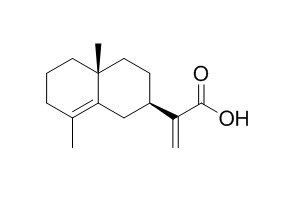Isocostic acid
Isocostic acid may have antibacterial activity.
Inquire / Order:
manager@chemfaces.com
Technical Inquiries:
service@chemfaces.com
Tel:
+86-27-84237783
Fax:
+86-27-84254680
Address:
1 Building, No. 83, CheCheng Rd., Wuhan Economic and Technological Development Zone, Wuhan, Hubei 430056, PRC
Providing storage is as stated on the product vial and the vial is kept tightly sealed, the product can be stored for up to
24 months(2-8C).
Wherever possible, you should prepare and use solutions on the same day. However, if you need to make up stock solutions in advance, we recommend that you store the solution as aliquots in tightly sealed vials at -20C. Generally, these will be useable for up to two weeks. Before use, and prior to opening the vial we recommend that you allow your product to equilibrate to room temperature for at least 1 hour.
Need more advice on solubility, usage and handling? Please email to: service@chemfaces.com
The packaging of the product may have turned upside down during transportation, resulting in the natural compounds adhering to the neck or cap of the vial. take the vial out of its packaging and gently shake to let the compounds fall to the bottom of the vial. for liquid products, centrifuge at 200-500 RPM to gather the liquid at the bottom of the vial. try to avoid loss or contamination during handling.
Mol Plant Pathol.2023, 24(2):123-141.
J Agric Food Chem.2024, 72(15):8784-8797.
Horticulture, Environment, and Biotechnology2025, 66:729-739.
Evid Based Complement Alternat Med.2017, 2017:1583185
Front Pharmacol.2021, 12:765521.
Biochem Pharmacol.2023, 211:115502.
Pharmaceutics.2023, 15(9):2355.
Korean J of Medicinal Crop Science2018, 220-226
Drug Test Anal.2018, 10(10):1579-1589
Molecules.2023, 28(4):1785.
Related and Featured Products
Der Pharmacia Lettre, 2012,4 (6):1878-1882
Antibacterial Activity and Chemical Composition of Essential Oils of Inula viscosa (L.) Ait. (Asteraceae) from Constantine, Algeria[Reference:
WebLink]
METHODS AND RESULTS:
The hydrodistilled essential oils of fresh aerial parts of I. viscosa (L.) Ait., collected at Ain El-Bey (Southern Constantine), was characterized by nerolidol (25.3%), Isocostic acid (10.1%), costic acid (8.0%), neo-intermedeol (6.4%) and caryophyllene oxide (5.5%), as major components. The essential oil of hydrodistilled fresh aerial parts of I. viscosa (L.) Ait., collected at Hamma-Bouziane (Northern Constantine), was mainly represented by Isocostic acid (25.1%), costic acid (15.2%), nerolidol (9.6%), linoleic acid (9.1%), neo-intermedeol (7.5%) and fokienol (7.2%). The present compositions are quite different from those reported for species growing over the world.
CONCLUSIONS:
The essential oil of the plant collected at Ain El-Bey inhibited considerably the growth of K. pneumoniae (24mm), P. aeruginosa ATCC (21mm), P. aeruginosa HS (21mm), E. coli ATCC (20mm) and E. coli HS (20mm) while the essential oil of the species growing at Hamma Bouziane exhibited a good antibacterial activity against P. aeruginosa ATCC (21mm), P. aeruginosa HS (21mm) and K. pneumoniae (20mm).
Tetrahedron.2015 April 1;71(13):2035–2042.
Acid-promoted opening of 4,5- and 3,4-epoxy eudesmane scaffolds from α-isocostic acid。[Reference:
WebLink]
METHODS AND RESULTS:
The acid-catalyzed rearrangement of epoxide 3a and 8a derived from sesquiterpernic Isocostic acid (1), the main component of Dittrichia viscosa, was studied using Lewis and Brönsted acids. Several new compounds were obtained with different selectivities depending on the catalyst used.
CONCLUSIONS:
These compounds were fully characterized by spectroscopic methods, and mechanistic explanations for their formation are proposed.



